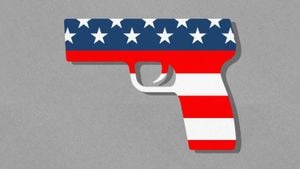The economic stage is buzzing with fresh indicators and predictive murmurs as the U.S. navigates through the aftermath of last year’s inflationary surge. Amidst the buzz, the spotlight is on the Federal Reserve's handling of interest rates and the broader economic narrative.
For those who haven't been following the financial radio waves, the U.S. economy recently demonstrated some vigor. The latest figures from the Bureau of Economic Analysis revealed GDP growth at a stunning 4.9% for the third quarter of 2023. This was much stronger than what many experts had anticipated. With consumers still reaching for their wallets, it appears many are unfazed by the inflationary pressures of the past year. Perhaps the holiday season is just around the corner, or maybe there’s just a pent-up desire to engage with the economy, but consumers are spending.
Despite this advantageous growth, the reality of interest rates looms large. The bank's rigorous campaign to combat inflation—raising rates multiple times—has been met with mixed reactions. Some sectors of the economy remain vulnerable. The housing market, for example, is still reeling from higher mortgage rates, which soared along with the Federal Reserve's aggressive stance. Buying homes has become noticeably challenging for many Americans, resulting in slower sales, though there are glimmers of activity and hope as some buyers wave their affordable housing flags.
Consumer confidence is also up—a resounding bounce back recorded this month. Respondents noted optimistic sentiments for jobs and business conditions, which is usually promising for consumption. A crescendo of confidence fuels spending, and it's being watched closely as economists wonder how long this can last without stoking new flames of inflation. After all, shopping sprees and newly bought homes change the dynamics faster than you think.
Now, let's not ignore what’s on the horizon: predictions. Key experts are speculating about what the Federal Reserve will do next. With one inflation figure indicating prices dipped slightly last month, there's some chatter about potentially pausing future rate hikes or mapping out scenarios for gradual reductions. Yet, many analysts remain cautious. The Fed's chair, Jerome Powell, has emphasized the economy is still very much on the knife's edge when it concerns inflation control.
The Fed has signaled it won’t shy away from maintaining its aggressive approach until the inflation rate dips closer to their 2% target. This figure has become almost mythical at this point, haunting central bankers and economic pundits alike. The labor market, as resilient as it is now, could play its own high-stakes game. Sustained pressure from employment could lead to price increases if wages rise too quickly. Powell and his team are well aware of this potential scenario, and they've been vocal about their concern for wage growth surpassing expectations.
Interestingly, inflation measures aren’t solely confined to the typical consumer goods. Rising costs for services, like healthcare, housing, and dining out, also contribute to the overall picture. Inflation isn't only stubborn; it appears it's also pervasive, affecting sectors and services previously thought to be immune. With this persistent pattern, there are insights being unearthed by various research groups indicating shifts in consumer spending behaviors. More individuals are expressing concerns about getting squeezed—not by loans, but by these service costs. Even families with stable incomes are feeling the pinch as they choose to save rather than spend more.
Meanwhile, international markets are sending their own messages. With various global economies citing high rates and slower growth, the U.S. dollar enjoys some spotlight, causing competitive ripples. The stronger dollar can create headwinds for U.S.-based exporters but also helps mollify import costs. The international lens can be complex but is ever-important for the U.S.'s economic strategy. Analysts are keeping their eyes peeled on inflation forecasts both domestically and abroad to discern the interplay of trends.
So, as we inch closer to 2024, questions linger around the Fed's next steps. What will they choose next: to press forward with rate hikes to tame inflation, or will they choose to ease back to cultivate sustained growth? The answer, it seems, has no clear path. Financial markets can be fickle, and the Fed's decisions can sway opinions rapidly, shifting moods almost instantaneously. One thing is for sure: the economy is continually pulsing with data, predictions, and sentiments. Paying attention will surely be worth the effort.
Until then, as households grapple with their own financial planning for the months and years to come, they’ll have to keep juggling the delicate balance between spending and saving as the economic stage evolves with each new indicator and whisper of change. The drama of economics is real, and everyone has front-row seats.



